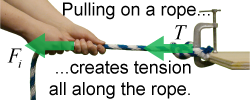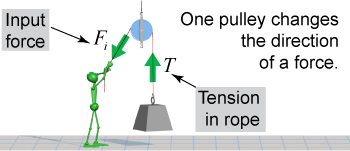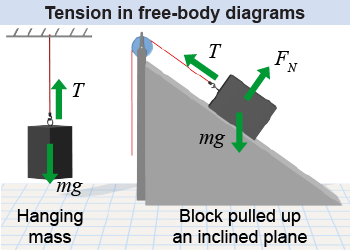|
Is the wheel on your school bus a lever? Is the rope and pulley used to lift a piano through a second story window a lever? The answer to both questions is yes! The lever is not just one type of simple machine: It is also a category that includes the pulley and the wheel and axle. In this section, you will learn why levers, pulleys, and wheels are related to each other. 
|
Ropes and pulleys
|
 To understand pulleys, we first need to understand the strings or ropes that pass around the pulleys. When you pull a rope with a force, you create tension in the rope. The rope carries that force all along its length so that the tension is the same everywhere along the rope. But the rope only has tension if both ends of the rope have a force applied—there is no tension if you drag the rope along the ground! Tension is a kind of force, so it has units of newtons (N). In rope and pulley diagrams, the rope’s tension is usually denoted by T.
To understand pulleys, we first need to understand the strings or ropes that pass around the pulleys. When you pull a rope with a force, you create tension in the rope. The rope carries that force all along its length so that the tension is the same everywhere along the rope. But the rope only has tension if both ends of the rope have a force applied—there is no tension if you drag the rope along the ground! Tension is a kind of force, so it has units of newtons (N). In rope and pulley diagrams, the rope’s tension is usually denoted by T. 
|
 A pulley is a wheel with a groove around the circumference to hold a rope or some similar flexible cord. A pulley is a machine that changes the direction of the force exerted by the rope. By using a pulley, you can lift a heavy object by pulling in a more convenient direction, such as down instead of up.
A pulley is a wheel with a groove around the circumference to hold a rope or some similar flexible cord. A pulley is a machine that changes the direction of the force exerted by the rope. By using a pulley, you can lift a heavy object by pulling in a more convenient direction, such as down instead of up. 
|
Although changing the direction of a force might be helpful, we often want a machine that changes the magnitude of a force, too, in order to lift something heavy. How can we use pulleys to lift heavy objects? As we will learn soon, combinations of pulleys can be used to change the magnitude of a force, not just its direction. 
|
 Earlier in the book, we learned how to draw free-body diagrams to identify all the forces acting on an object. The tension in a rope or string is also a force, so tension must also be identified and labeled on free-body diagrams. The illustration at right shows the direction of the tension force on two blocks. Notice that the tension vector always acts along the direction of the rope, and it always pulls.
Earlier in the book, we learned how to draw free-body diagrams to identify all the forces acting on an object. The tension in a rope or string is also a force, so tension must also be identified and labeled on free-body diagrams. The illustration at right shows the direction of the tension force on two blocks. Notice that the tension vector always acts along the direction of the rope, and it always pulls. 
|
A rope is not the only kind of material that can exhibit tension! In a more general sense, tension is an outward force on an object that acts to stretch it (and so is the opposite of compression). You can create tension in both a rubber band and a steel beam by pulling on them—although you have to pull harder on one than the other. The tension in those cases is a force that acts to resist the stretching. How can a bug called a water strider seemingly “walk” on water? The weight of the bug acts to expand the surface area of the water. The surface tension of the water resists the bug’s weight, applying an upward force to keep it on top of the water! 
|
Two teams are playing a game of tug-of-war using the two ends of a heavy rope. The team on the left applies 1,200 N of force to its end of the rope, while the team on the right applies 1,200 N of force to its end. What is the tension in the middle of the rope?
 |
The tension is 1,200 N—not 2,400 N! Tension only occurs when someone or something pulls on both ends of a rope equally. If the left-hand team gave up and let go, then there would be no tension at all in the rope. The rope (and the right-hand team) would fall to the ground! 
|

